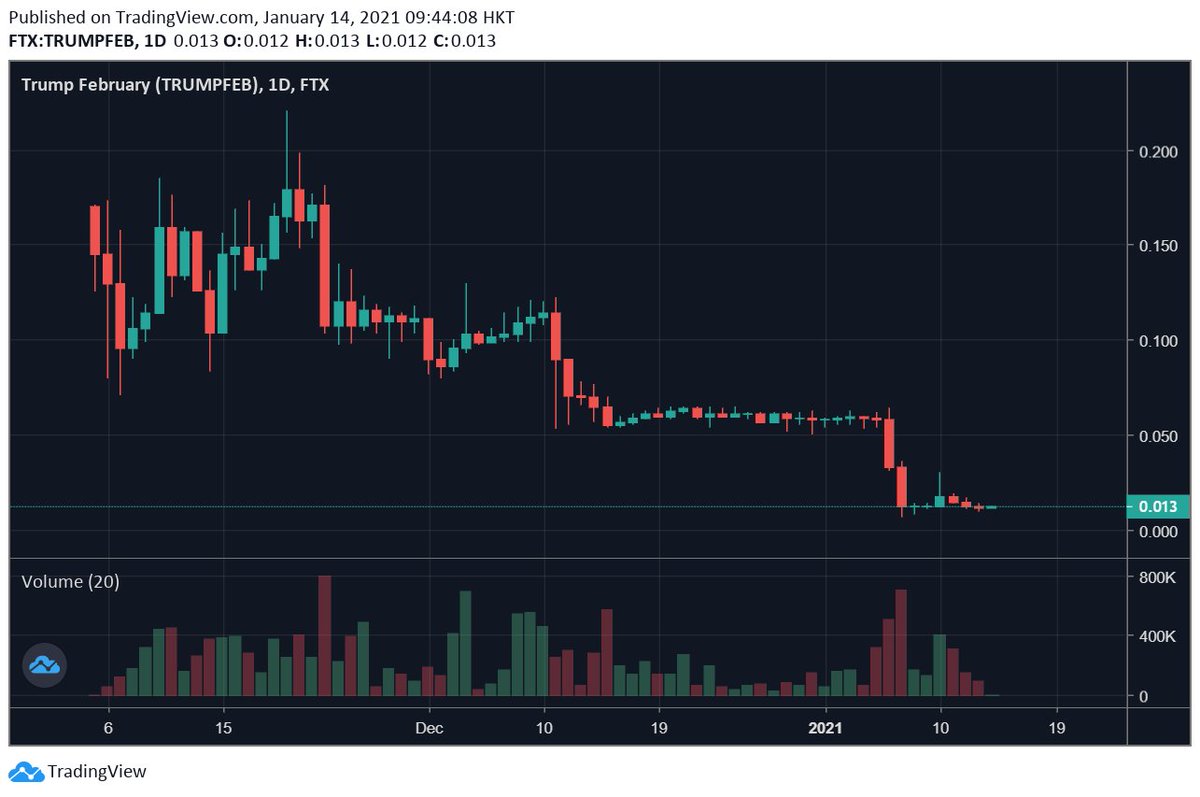
Ah, election trading. I think trading the election in November was some of the most fun I've ever had in my life ... for the first day. Maaaybe the second.
Kinda wasn't expecting it to last 3 months.
Kinda wasn't expecting it to last 3 months.
https://twitter.com/AlamedaTrabucco/status/1324280271508631552?s=20
But, always a silver lining: people were bidding TRUMPFEB high. WAY higher than we ever thought was reasonable -- we couldn't find a single informed source who honestly believed the probability of Trump remaining in office was higher than 1% or so. And LOOK at this chart! 

We quickly decided we believed our fair way more than the market and that there were no real selection effects here -- it all became a question of maximizing the amount of $ we could make from selling into the bids.
Also, to pre-empt! "We" is Alameda Research, the trading firm where I work. "We" is not FTX, the exchange where this product trades! We used FTX to trade it, we are not FTX, and we have no real idea who we were trading against except that some of them have harassed me on Twitter.
Well, it started out bid ... .15 or so. Level one thought: we could just sell it down to our fair + .01 or something and keep selling. But that caps the price for future bids at .02! And maybe every bid will be price-insensitive -- god knows the initial ones seemed so.
So instead, we could just sell .15s (maybe .14s too) and see what happens. And the bids kept refreshing! So we kept stepping our offers UP ... and no one came in to sell more aggressively, somehow? Not for size anyway. And the bids got met us up at .20!
This went on for WEEKS! We maybe cut the amount of *contracts* we sold in half or something -- but the price at which we sold? At least 5 times as high as otherwise. This was great! We figured out how to get more $ in when (we believe) the $ was GREAT.
(And it did slow, others did start selling, buying appetites did wane, etc. -- but like, not quickly enough, and we sold a LOT, and WAY over our fair -- we really, really liked these trades :D)
But ... did we really kill it? Eh. I think from day 2 on, basically, yeah, we got as much $ in as we could. But day 1 ... bids were price-insensitive. Would they have paid .30? .50? Higher???
We don't know! We put up a TON of offers way below that. Maybe more sellers come in if it gets higher, maybe fewer people buy -- but there was a chance, and we ruined it for ourselves.
Thinking about maximizing edge ALL the time -- even when the decision won't really matter for hours, or days, or, in this case, kinda weeks -- is critical, and counter-intuitive, and hard -- but nailing it all the time pays rich dividends, and we didn't *totally* nail this.
• • •
Missing some Tweet in this thread? You can try to
force a refresh




